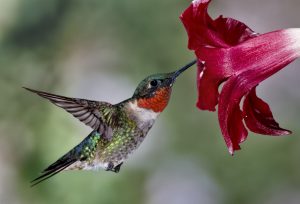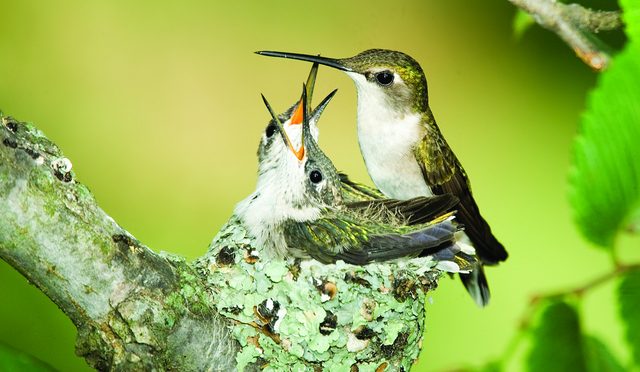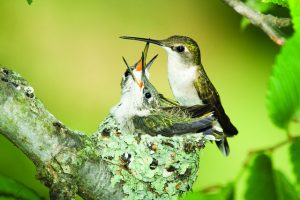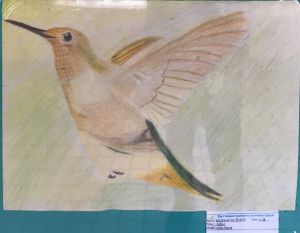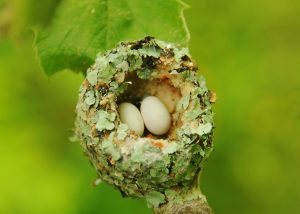| Common Name | (in English) Ruby-throated Hummingbird |
| (in Chinese) 紅喉北蜂鳥 | |
| Scientific Name | (in Latin) Archilochus colubris |
| Peculiar characteristics / external features: | The hummingbird is from 7 to 9 cm long and has an 8 to 11 cm wingspan. Weight can range from 2 to 6 g, with males averaging 3.4 g against the slightly larger female which averages 3.8 g. Adults are metallic green above and greyish white below, with near-black wings. The species is sexually dimorphic. The adult male has a gorget (throat patch) of iridescent ruby red bordered narrowly with velvety black on the upper margin and a forked black tail with a faint violet sheen. The red iridescence is highly directional and appears dull black from many angles. The female has a notched tail with outer feathers banded in green, black, and white and a white throat that may be plain or lightly marked with dusky streaks or stipples. Males are smaller than females and have slightly shorter bills. Juvenile males resemble adult females, though usually with heavier throat markings. |
| Distributions: | Ruby-throated Hummingbirds (Archilochus colubris) make a spring migration from their over-wintering grounds in Mexico and Central America to the central and eastern United States and southern Canada. Their high energy needs require that abundant supplies of nectar be available throughout the migration corridor, which can range through thousands of miles of habitat. |
| Habits: | |
| l Dietary | Although Ruby-throated Hummingbirds are well recognized as nectar feeders, they also eat spiders and tiny insects such as flies, gnats and aphids as a source of fat and protein. These foods help hummingbirds to nearly double their weight (from about 3.25 grams to 6 grams) before crossing the Gulf of Mexico. A single migration can become a nonstop flight of up to 500 miles over a period of 18 to 22 hours. |
| l Reproductive (Solitary/Social/Territorial, Courtship Behavior, Taking care of youngs, etc) | As typical for their family, ruby-throated hummingbirds are thought to be polygynous. Polyandry and polygynandry may also occur. They do not form breeding pairs, with males departing immediately after the reproductive act and females providing all parental care. |
| l Whatever appropriate | Wildflowers that appeal most to hummingbirds include species with red or orange coloration, long, tubular flower shape, and lots of dilute nectar. Some hummingbird favorites include native wildflowers such as trumpet honeysuckle (Lonicera sempervirens), scarlet beebalm (Monarda didyma), lemon beebalm (Monarda citriodora), wild bergamont (Monarda fisulosa), cardinal flower (Lobelia cardinalis), and trumpet creeper (Campsis radicans). Spring migrations of the Ruby-throated Hummingbird coincide with flowering periods of red buckeye (Aesculus pavia), clove currant (Ribes aureum var. villosum), and columbine (Aquilegia canadensis). The diverse Salvia genus, many of which are native to the western United States, offers many plants that are widely appealing to hummingbirds and other pollinators. |
| Interesting Fact: | Some scientists believe that as many as 19 species of plants found in the eastern United States have co-evolved with hummingbirds, noting the relationships between the tubular shape of certain flowers and the length and shape of a hummingbird’s bill. The hummingbird laps up nectar by flicking its long, forked tongue deep within a flower at rates up to ten times per second. It forages while hovering airborne, inadvertently collecting pollen on its feathers and bill before darting off to its next meal. Its efficiency as a pollinator is comparable to that of a honey bee. |
References:
http://www.audubon.org/field-guide/bird/ruby-throated-hummingbird
https://www.thespruce.com/ruby-throated-hummingbird-identification-385991
